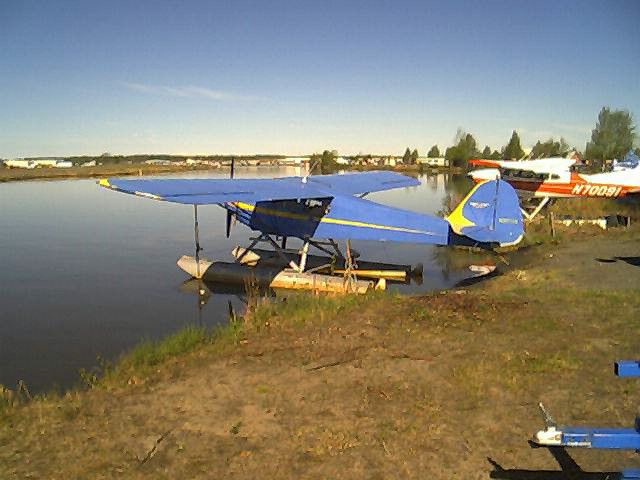Cessna over Safeway Parking lot, NorthWay Mall,
landing at Merrill Field across the street (June 2000)

Flying in Alaska is a very rewarding and adventuresome experience. It can be done safely, but you'd better know what you are doing before you venture far from the local airport. A recent event has had a major effect on the availability of rental aircraft. The cost of insurance was raised dramatically a few months ago, and as a result many FBO's no longer offer aircraft rentals. Some have closed permanently, and even small scale commercial operations have been seriously affected. The potential for anyone to come up, get a check out and fly off somewhere is not as good as it was even recent years.
Alaska is a flying state. Many communities cannot be reached by any other means because there are no roads or trains to these communities. There are more pilots, and more aircraft, in Alaska than in any other state. Anchorage, Alaska, is the seaplane capital of the world. In addition to seaplanes and float planes, there are plenty of fixed wing land aircraft, commercial airliners, and military aircraft. In Alaska you can see, and fly in, helicopters, ultralights, hovercraft, and hot air balloons. Alaska even has its own rocket launching site where commercial rockets do their Cape Canaveral type "thing".
Flight seeing is a popular way to see Mt. McKinley, glaciers and wildlife. Emergency crews, geologists, and division of wildlife employees use aircraft regularly. Aircraft charters are available for hunting and fishing trips as well. There are nostalgic flights available in vintage aircraft. There is an aviation museum in Anchorage, near the International Airport, and also in Fairbanks.

Lake Hood Sea Plane Base
If you do fly in the Anchorage bowl area you should be aware there are special rules to follow because of the density of air traffic there. The specific altitudes, corridors, and frequencies are listed in FAR Part 93, described in the Anchorage Terminal Area Pilot Bulletin, current Edition. It is also referred to as Section 93.55 Subdivision of the Terminal Area. You should not fly into the area without having reviewed that document. There are six segments covered, including the Anchorage International Airport, Lake Hood (sea plane and land plane base), Merrill Field, Elmendorf Air Force Base, Bryant Segment, and the Seward Highway Segments.
Wilderness survival is an interesting topic, and potentially very valuable to air travelers in Alaska. There are many natural resources that can be utilized if proper planning has been completed prior to an unplanned off-airport landing. Relatively simple measures can literally save a life. An aircraft departing from Anchorage can be over wilderness areas within minutes, and if the plane goes down the occupants must be prepared for that possibility. Survival gear is required to be carried in all aircraft flying cross-country in Alaska. The exact minimum contents of the survival bag is described in a booklet called the Alaska Supplement. Even in the summer season, it can still be winter at any time of year in high mountainous areas.
Training in survival techniques is much better than simply waiting until something happens and then beginning to figure out how to start a fire with wet wood and no matches, how to gather food, and how to build an emergency signal fire. A search of the Internet recently listed over 3,000 sites which relate to wilderness survival. This web site will not attempt to duplicate all of the material that already exists. Click on the links below for some examples of material available on this subject.

Survival information
Wilderness Survival Website
FLYING LINKS
Aviation Heritage Museum
Aviation Resource Link
Federal Aviation Administration
Aviation Weather
 Return to Contents/Links Page
Return to Contents/Links Page Return to Home Page
Return to Home Page
